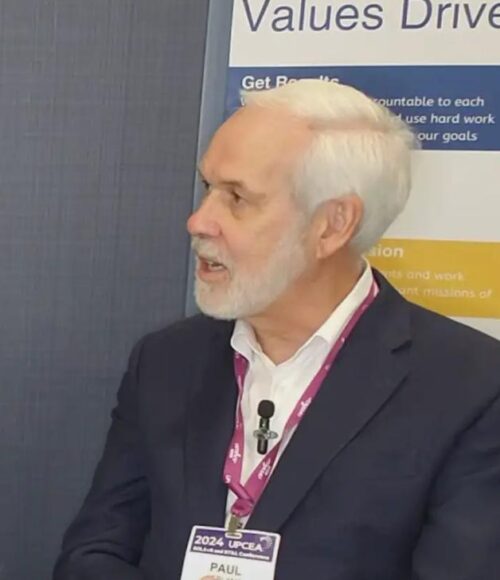Paul LeBlanc’s Students-First Approach to Higher Education

Paul LeBlanc’s Students-First Approach to Higher Education
This blog post was written based on a conversation between Lee Maxey and Paul LeBlanc, author of Students First: Equity, Access, and Opportunity in Higher Education.
Watch the full conversation here.
We’ve all had teachers who changed our lives—those special individuals who seemed to see in us all that we had to offer, even when we couldn’t see it ourselves.
For Paul LeBlanc, former president of Southern New Hampshire University, three teachers did just that. As he recounted in a recent conversation with MindMax’s Lee Maxey, these teachers “made me feel like I mattered…they gave me their time, they lifted my sights, and helped me dream bigger dreams.”
Just as an individual teacher can change the life of a single student, Dr. LeBlanc believes an entire institution can adopt a “students first” approach on a larger scale. But what does it mean for a university to truly put students first?
The Power of Connection in Education
At the heart of putting students first is the belief that students need to feel seen, understood, and supported in a meaningful way. When institutions go beyond academics to show a genuine investment in students’ lives and well-being, barriers are broken, and students have opportunities they never would have had before.
At SNHU, this approach has led to the development of policies and practices that prioritize the needs of students—particularly non-traditional students like working adults. A key example is SNHU’s decision to simplify the process of students retrieving transcripts for transfer credits.
Understanding that many students struggled to obtain these documents during regular business hours, the university began handling transcript requests on behalf of students. “We even pay the $10,” says Dr. LeBlanc. “It’s about knowing your students and putting their needs before your own.” This small but significant change reflects a larger commitment to making education more accessible and removing obstacles that can stand in the way of success.
Challenging the Structures of Higher Education
A key challenge in higher education is the outdated systems that many institutions continue to rely on—systems that often disadvantage non-traditional learners. The credit hour system is a prime example of this structural inequity.
Designed to measure time rather than learning, the credit hour determines federal financial aid eligibility based on the hours a student spends in class. But this model doesn’t account for students who need more flexibility in their education due to work, family, or other commitments.
Putting students first means recognizing and responding to their unique needs rather than expecting them to fit into a rigid system.
To that end, SNHU adopted self-paced learning models that allow students to progress at their own speed. Dr. LeBlanc shares the story of a single mother in one of SNHU’s competency-based programs who was able to balance caring for a chronically ill child while pursuing her degree. “I’m the calendar now,” the student said, describing the freedom she had to pause her education when needed, without penalty.
This flexible approach empowers students to succeed on their own terms, challenging the rigid structures that have long governed higher education.
The Role of Technology in Supporting Students
As technology continues to evolve, it presents opportunities and challenges for education. Artificial intelligence (AI) and other innovative technologies have the potential to enhance learning by offering personalized, scalable support. However, that technology should never replace the human element.
The key to success is finding the right balance between technology and human connection. While AI can help institutions better understand and meet the needs of their students, it’s the relationships between students and advisors that make the real difference.
At SNHU, academic advisors play a central role in students’ success, guiding them through academic and personal challenges. Dr. LeBlanc describes the advisors as “life coaches,” with 80% of their work focused on supporting students’ personal growth and well-being.
With a true student-first approach, technology should be used to free up time for these essential human interactions—not replace them.
Adapting to a Changing World
Higher education must adapt to the changing needs of students and the world around them. Dr. LeBlanc warns against institutions becoming too comfortable with their existing models, stressing the importance of continuous evolution. He believes that while the mission and values of an institution should remain constant, the methods used to deliver education must evolve to meet the needs of new generations of students.
At SNHU, this evolution has involved embracing new learning models, technologies, and approaches to student support. Many institutions get into trouble by locking into a single way of operating rather than staying flexible and responsive to change. “You better hope [the next leader] changes this place,” Dr. LeBlanc says, speaking to the need for institutional agility.
Higher Education’s Transformational Potential
At its best, higher education should do more than prepare students for jobs. It should transform lives, helping students become better versions of themselves. This transformation often hinges on the support students receive along the way—whether from a teacher, an advisor, or the institution itself.
Putting students first means creating an educational experience that is not only about content delivery but also about fostering personal growth. It means designing systems that understand and support students’ diverse needs—from offering flexible learning options to addressing structural inequities to maintaining human connections in a technology-driven world.
Dr. LeBlanc’s vision for the future of higher education is one where institutions adapt to meet the evolving needs of students while staying true to their mission of transformation and growth. The question every institution should ask is: How can we put students first—not just in theory but in practice?
Contact MindMax to explore how we can partner with your school to create a more student-centered experience.